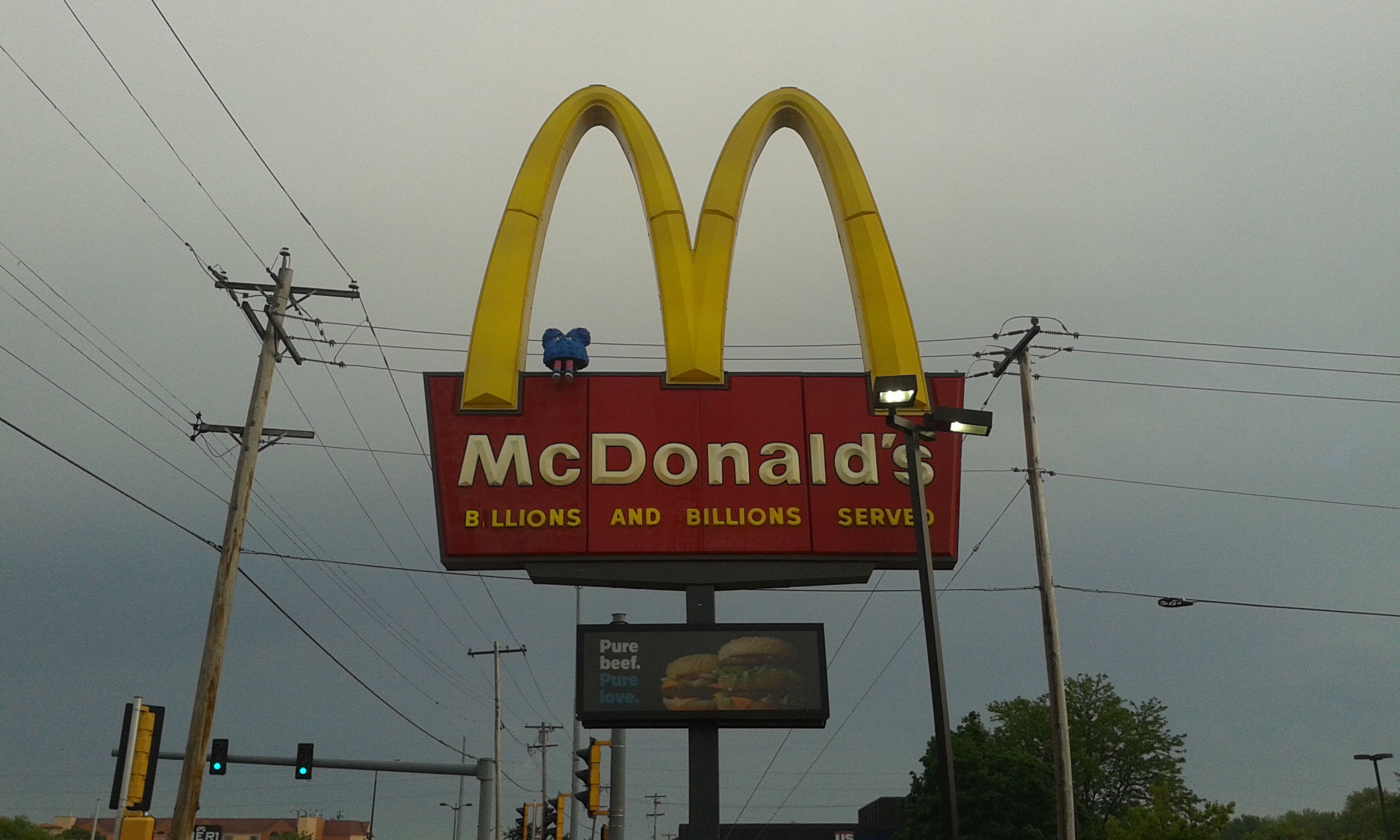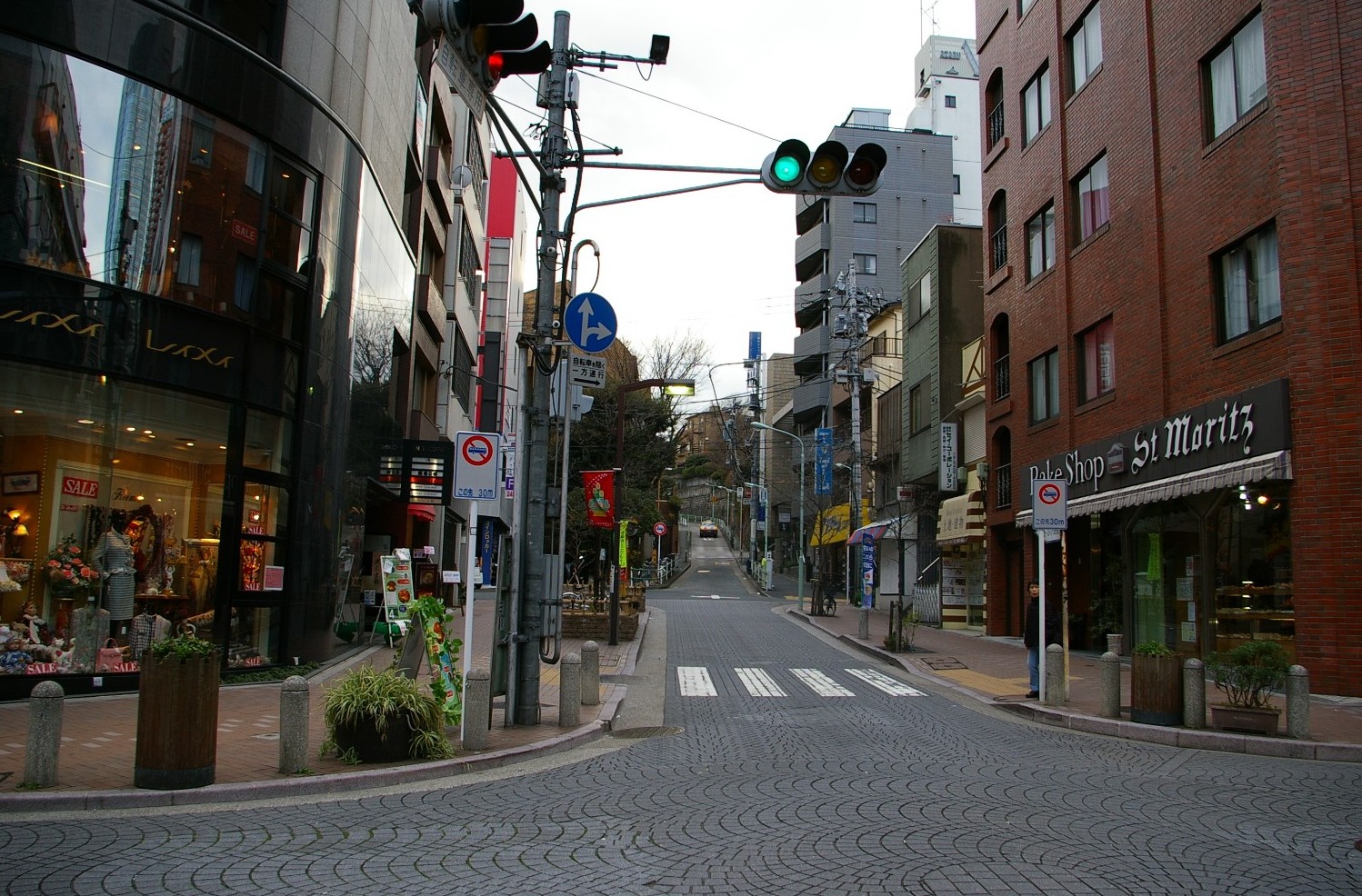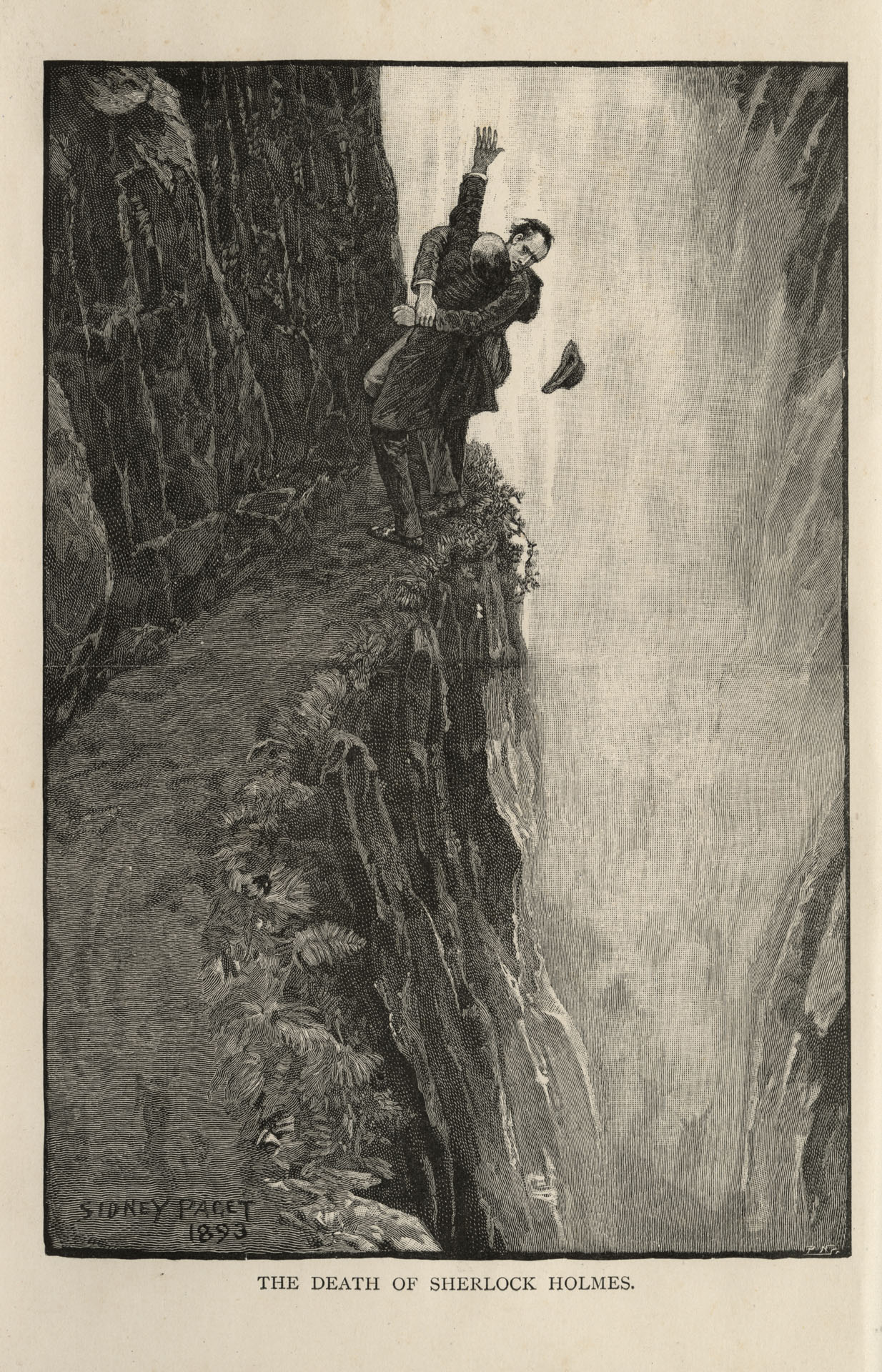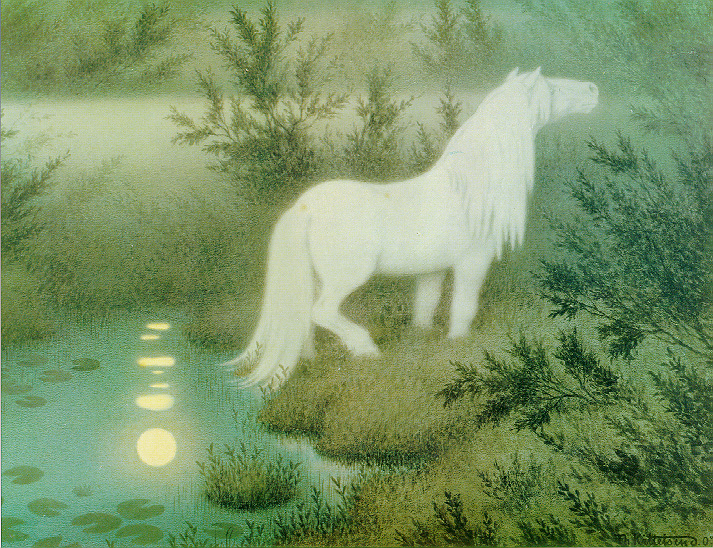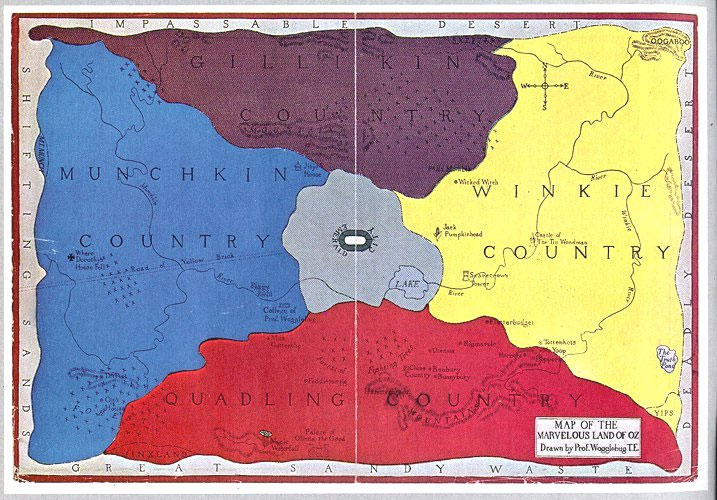|
Mcdonaldland
McDonaldland is a McDonald's media franchise and the fictional fantasy world inhabited by Ronald McDonald and his friends. Starting with the creation of Ronald McDonald in 1963 it is primarily developed and published by McDonald's, initial attempts to expand the McDonaldland universe by Needham, Harper & Steers were seemingly retconned due to legal issues, but ongoing aspects were expanded in McDonald's projects in collaboration with Data East, Virgin Interactive, Treasure, SEGA, and Klasky Csupo. The series centers on an adventuring magical clown named Ronald McDonald, who has red hair, white and red facepaint, and wears a yellow jumpsuit over a red and white striped long-sleeve shirt with yellow gloves. His most regularly occurring friends are Grimace, the Hamburglar, Birdie the Early Bird, the Fry Kids, the McNugget Buddies, and the Happy Meal Gang. The fictional world has a variety of inspirations from general high fantasy and low fantasy, to corporate culture and corporate ... [...More Info...] [...Related Items...] OR: [Wikipedia] [Google] [Baidu] |
Donald Land
is a 1988 Platform game, platform video game produced by Data East in association with the McDonald's, McDonald's Corporation for the Nintendo Entertainment System, Family Computer. It appears to be related to the McDonaldland concept, but has no relation to ''M.C. Kids'' or any other McDonald's-themed video game. Gameplay Unlike the commonly compared ''M.C. Kids'', ''Donald Land'' is simply a platformer without any puzzle elements to it. The game centers on Ronald McDonald (often known in Japan as Donald McDonald) Most of Ronald's companions have been kidnapped and all the animals have turned feral. His brainwashed companions will occasionally attack. Ronald can defend himself using apple bombs, thrown in a carefully calculated parabola. Being hit by an enemy causes damage, which decreases Ronald's "Life" meter. During various parts of a stage, players have the opportunity to collect up to 100 hamburger icons throughout the game. This will result in gaining a bonus life along ... [...More Info...] [...Related Items...] OR: [Wikipedia] [Google] [Baidu] |
The Wacky Adventures Of Ronald McDonald
''The Wacky Adventures of Ronald McDonald'' is an American animated miniseries of retail direct-to-video episodes produced by Klasky Csupo in association with the McDonald's Corporation, centering on McDonald's mascot Ronald McDonald and the gang in McDonaldland. A total of six 40-minute episodes were produced and released on VHS with five of them being available exclusively in participating McDonald's restaurants from October 9, 1998 to January 30, 2003. Production Mark and Bob Mothersbaugh (best known as members of the band Devo and composers of the music for ''Rugrats'', another Klasky Csupo series) composed the score of the series while John Holmquist (who has also directed some ''Rugrats'' episodes) directed the first episode of the series. The artistic style of the series has a similar look to ''Rugrats'', ''Aaahh!!! Real Monsters'', ''The Wild Thornberrys'', and ''Rocket Power'' (another Klasky Csupo series). The background music was recycled from later episodes of Nickelo ... [...More Info...] [...Related Items...] OR: [Wikipedia] [Google] [Baidu] |
McDonald's Treasure Land Adventure
is a 1993 platform game developed by Treasure and published by Sega for the Genesis. Based on the McDonald's fast food restaurant chain, specifically its McDonaldland marketing campaign, players control Ronald McDonald in his efforts to retrieve the missing pieces of a map that lead to the location of a buried treasure from a group of villains. Ronald can defeat enemies by using a magic attack and can latch onto hooks with his scarf to reach higher platforms. ''Treasure Land Adventure'' was developed by Treasure in conjunction with the run and gun shooter ''Gunstar Heroes'' (1993). Sega commissioned Treasure to design a McDonald's game after the company was ineligible to receive a publishing contract to develop games for the Genesis. Treasure president and project programmer Masato Maegawa mandated that the game had to be faithful and respectful to the McDonald's licensing and characters during production. Both at release and retrospectively, the game was praised for its gamepl ... [...More Info...] [...Related Items...] OR: [Wikipedia] [Google] [Baidu] |
Ronald McDonald
Ronald McDonald is a clown character used as the primary mascot of the McDonald's fast-food restaurant chain. He inhabits the fictional world of McDonaldland, with his friends Mayor McCheese, the Hamburglar, Grimace, Birdie the Early Bird and The Fry Kids. Many people work full-time making appearances as Ronald, visiting children in hospitals and attending regular events. At its height, there may have been as many as 300 full-time clowns at McDonald's restaurants. There are also Ronald McDonald Houses, where parents can stay overnight with their sick children in nearby chronic care facilities. History Washington, DC "Ronald McDonald, the Hamburger-Happy Clown" originally appeared in 1963 on three separate local television spots. The advertisements were created by the advertising agency of Oscar Goldstein, who doubled as a McDonald's franchisee in the Washington, DC area. The first person to portray Ronald was Willard Scott, who had played Bozo the Clown on WRC-TV in Washin ... [...More Info...] [...Related Items...] OR: [Wikipedia] [Google] [Baidu] |
Happy Meal
A Happy Meal is a kids' meal usually sold at the American fast food restaurant chain McDonald's since June 1979. A small toy or book is included with the food, both of which are usually contained in a red cardboard box with a yellow smiley face and the McDonald's logo. The packaging and toy are frequently part of a marketing tie-in to an existing television series, film or toyline. Description The Happy Meal contains a main item (a hamburger, cheeseburger or small serving of Chicken McNuggets), a side item ( French fries, apple slices, a Go-Gurt tube or a salad in some areas) and a drink (milk, juice or a soft drink). The choice of items changes from country to country and may depend on the size of the restaurant. In some countries, the choices have been expanded to include items such as a grilled cheese sandwich (known as a "Fry Kid"), or more healthy options such as apple slices, a mini snack wrap, salads or pasta, as one or more of the options. History In the mid-1970s ... [...More Info...] [...Related Items...] OR: [Wikipedia] [Google] [Baidu] |
McDonald's
McDonald's Corporation is an American Multinational corporation, multinational fast food chain store, chain, founded in 1940 as a restaurant operated by Richard and Maurice McDonald, in San Bernardino, California, United States. They rechristened their business as a hamburger stand, and later turned the company into a Franchising, franchise, with the Golden Arches logo being introduced in 1953 at a location in Phoenix, Arizona. In 1955, Ray Kroc, a businessman, joined the company as a franchise agent and proceeded to purchase the chain from the McDonald brothers. McDonald's had its previous headquarters in Oak Brook, Illinois, but moved its global headquarters to Chicago in June 2018. McDonald's is the world's largest restaurant chain by revenue, serving over 69 million customers daily in over 100 countries in more than 40,000 outlets as of 2021. McDonald's is best known for its hamburgers, cheeseburgers and french fries, although their menus include other items like ch ... [...More Info...] [...Related Items...] OR: [Wikipedia] [Google] [Baidu] |
Charlton Comics
Charlton Comics was an American comic book publishing company that existed from 1945 to 1986, having begun under a different name: T.W.O. Charles Company, in 1940. It was based in Derby, Connecticut. The comic-book line was a division of Charlton Publications, which published magazines (most notably song-lyric magazines), puzzle books and, briefly, books (under the Monarch and Gold Star imprints). It had its own distribution company (Capital Distribution). Charlton Comics published a wide variety of genres including; crime, science fiction, Western, horror, war and romance comics, as well as talking animal and superhero titles. The company was known for its low-budget practices, often using unpublished material acquired from defunct companies and paying comics creators among the lowest rates in the industry. Charlton was also the last of the American comics publishers still operating to raise its cover prices from ten cents to 12 cents in 1962. It was unique among comic book co ... [...More Info...] [...Related Items...] OR: [Wikipedia] [Google] [Baidu] |
Azabu-Jūban
is a district of Minato, Tokyo, Japan. It consists of 1 to 4-chōme. Azabu-Jūban Station is located in this district. Azabu-Juban is a residential area in central Tokyo with a mixture of Japanese shops, restaurants and bars. The convenience of several supermarkets in a central location and the proximity of Hiroo and Roppongi make it one of the most trendy and sought after residential areas of Tokyo. The main street, a block away from a busy road junction, has a village-like feel with cobbled stoned paving in some places. This atmosphere is created by the narrow streets, slow moving traffic, and a mixture of stores operated by older owners. Even the McDonald's has been carefully designed to be architecturally sympathetic. Azabu-Juban is known for being the main setting of the famous magical girls manga/anime series, '' Sailor Moon''. Azabu-Juban matsuri In the middle of August (usually at the beginning or end of the Japanese Obon holiday), Azabu-Juban holds one of the most ... [...More Info...] [...Related Items...] OR: [Wikipedia] [Google] [Baidu] |
High Fantasy
High fantasy, or epic fantasy, is a subgenre of fantasy defined by the epic nature of its setting or by the epic stature of its characters, themes, or plot.Brian Stableford, ''The A to Z of Fantasy Literature'', (p. 198), Scarecrow Press, Plymouth. 2005. The term "high fantasy" was coined by Lloyd Alexander in a 1971 essay, "High Fantasy and Heroic Romance", which was originally given at the New England Round Table of Children's Librarians in October 1969. Characteristics High fantasy is set in an alternative, fictional ("secondary") world, rather than the "real" or "primary" world. This secondary world is usually internally consistent, but its rules differ from those of the primary world. By contrast, low fantasy is characterized by being set on Earth, the primary or real world, or a rational and familiar fictional world with the inclusion of magical elements. The romances of William Morris, such as ''The Well at the World's End'', set in an imaginary medieval world, are ... [...More Info...] [...Related Items...] OR: [Wikipedia] [Google] [Baidu] |
Retroactive Continuity
Retroactive continuity, or retcon for short, is a literary device in which established diegetic facts in the plot of a fictional work (those established through the narrative itself) are adjusted, ignored, supplemented, or contradicted by a subsequently published work which recontextualizes or breaks continuity with the former. There are various motivations for applying retroactive continuity, including: * To accommodate desired aspects of sequels or derivative works which would otherwise be ruled out. * To respond to negative fan reception of previous stories. * To correct and overcome errors or problems identified in the prior work since its publication. * To change or clarify how the prior work should be interpreted. * To match reality, when assumptions or projections of the future are later proven wrong. Retcons are used by authors to increase their creative freedom, on the assumption that the changes are unimportant to the audience compared to the new story which can be tol ... [...More Info...] [...Related Items...] OR: [Wikipedia] [Google] [Baidu] |
Fantasy World
A fantasy world is a world created for/from fictional media, such as literature, film or games. Typical fantasy worlds involve magic or magical abilities, nonexistent technology and, sometimes, either a historical or futuristic theme. Some worlds may be a parallel world connected to Earth via magical portals or items (like Narnia); an imaginary universe hidden within ours (like Wizarding World); a fictional Earth set in the remote past or future (like Middle-earth); an alternative version of our History (like Lyra's world); or an entirely independent world set in another part of the universe (like the '' Star Wars'' Galaxy). Many fantasy worlds draw heavily on real world history, geography, sociology, mythology, and folklore. Plot function The setting of a fantasy work is often of great importance to the plot and characters of the story. The setting itself can be imperiled by the evil of the story, suffer a calamity, and be restored by the transformation the story brings ab ... [...More Info...] [...Related Items...] OR: [Wikipedia] [Google] [Baidu] |
Fictional Universe
A fictional universe, or fictional world, is a self-consistent setting with events, and often other elements, that differ from the real world. It may also be called an imagined, constructed, or fictional realm (or world). Fictional universes may appear in novels, comics, films, television shows, video games, and other creative works. The subject is most commonly addressed in reference to fictional universes that differ markedly from the real world, such as those that introduce entire fictional cities, countries, or even planets, or those that contradict commonly known facts about the world and its history, or those that feature fantasy or science fiction concepts such as magic or faster than light travel—and especially those in which the deliberate development of the setting is a substantial focus of the work. When a large franchise of related works has two or more somewhat different fictional universes that are each internally consistent but not consistent with each other (su ... [...More Info...] [...Related Items...] OR: [Wikipedia] [Google] [Baidu] |
